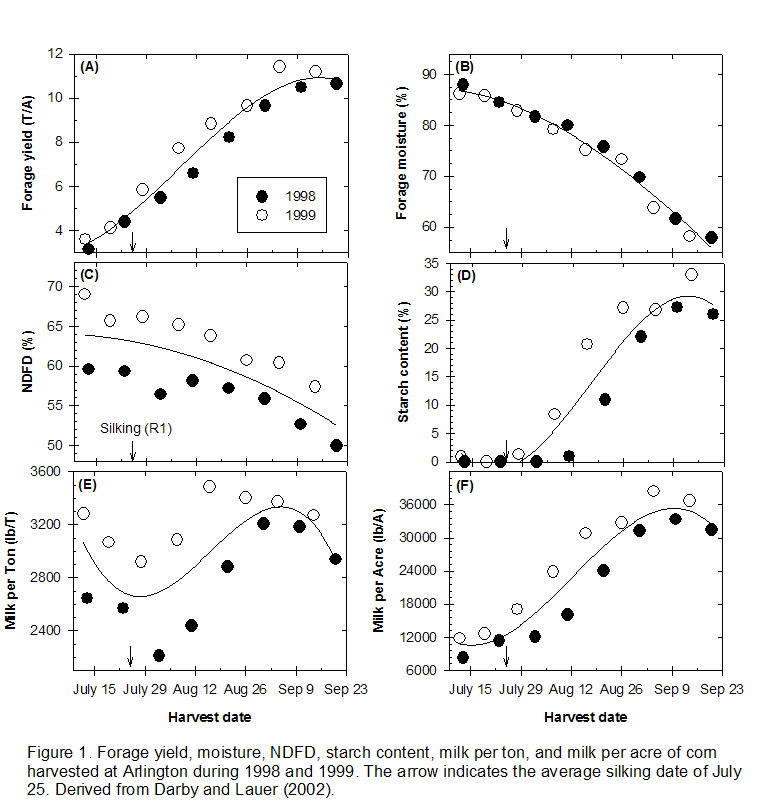Handling Corn in an "Emergency" Forage Season: Changes in Quality
Joe Lauer , Corn Agronomist
In an emergency season, farmers desire to maximize forage yield often at the expense
of optimizing forage quality. This article discusses some guidelines for producing
the best forage quality possible in spite of a bad situation. Figure 1 describes
an example of the trade-off between corn forage yield and quality during the life
cycle of the corn plant (Darby and Lauer, 2002). Most corn planted around July 1
will likely only develop to the flowering stage (tasseling, VT and silking, R1).
First, some definitions regarding corn forage quality. Corn forage quality is calculated
using the model Milk2000 (Schwab et al., 2003) and expressed as milk per ton which
provides an overall estimate. Two important measurements used in Milk200 for calculating
milk per ton are NDFD and starch content. NDFD measures the digestibility of the
stover. Starch content measures the amount of starch in the forage and is considered
85 to 100% digestible by dairy cows.
Corn forage is unique among forages. Like most other forages, optimum quality occurs
just prior to flowering (Figure 1E). Like other forages, quality decreases as harvest
is delayed after flowering due to decreasing stover digestibility (Figure 1C). Unlike
other forages, as corn nears maturity, quality improves due greater starch content
in corn grain (Figure 1D). By maturity forage yield (Figure 1A), milk per ton (Figure
1E), and milk per acre (Figure 1F) are maximized. Harvest timing is dependent upon
optimum moisture content (Figure 1B) for the storage structures.
In an emergency forage season where corn is planted around July 1, the objective
of corn production changes to maximizing stover yield and quality. Corn stover yield
is maximized at flowering (derived Darby and Lauer, 2002). Likewise corn stover
quality is at a maximum just prior to flowering (Figure 1E).
At least three hybrid selection options exist: 1) ultra-short-season hybrids to
produce some grain; 2) full-season hybrids or longer to flower around the frost
killing date; and or 3) hybrids with improved stover digestibility traits. Whether
one chooses an ultra-short-season hybrid or a full-season hybrid, the success of
your decision hinges upon your ability to predict GDU accumulation for the remainder
of the growing season and the fall killing freeze date.
Planting corn around July 1 results in good stover yield, but relatively low grain
yield that is decreasing 2.5 to 3 % for each day delay (Lauer, 1997). Late-April
and early-May are optimum dates for corn planting and by June 20, only 3 to 32 %
grain yield is produced depending upon location. For most years planting corn July
1 or later will not produce grain, but your chances of producing at least some grain
improve in southern Wisconsin when using ultra-short-season hybrids. For example
at Arlington in 1997, a 75 day hybrid produced 41 bu/A when planted on July 1 (Oplinger
and Lauer, 1997).
It may be more feasible to plant a full-season hybrid to maximize stover yield and
not be concerned about grain yield. Selecting a hybrid that nears flowering prior
to a killing frost will take full advantage of the remaining growing season. Like
most forages, corn has high milk per ton prior to flowering (R1) that subsequently
declines (Figure 1E). Greatest stover yield will be produced with full-season hybrids.
Stover yield increases 0.5 T dry matter/A for every 10 RM units (derived from Lauer
et al., 2001 and SELECT: 1990-1995).
Finally, selecting a hybrid that has improved stover traits might maximize forage
quality. An example of a hybrid with improved stover quality is bmr hybrids, although
seed companies have been very active in developing and identifying hybrids with
greater NDFD. Visit with seed company representatives regarding NDFD traits of hybrids.
Keep in mind though that little research is available regarding quality differences
at silking between hybrids.
A significant challenge in managing emergency corn forage is timing harvest. Proper
forage moisture is critical for fermentation and preservation. Corn planted around
July 1 will likely only develop to flowering (R1) and be too wet for ensiling until
after a fall killing frost (Figure 1B). After a killing frost forage moisture will
have to be monitored closely. The problem is that all emergency planted acres on
a farm will need to be chopped within a relatively short harvest window. Custom
choppers will not be able to get to all late-planted fields in a timely manner.
In conclusion, corn planted around July 1 as "emergency" forage has relatively good
forage production potential compared to other forages. During the life cycle of
corn, forage quality is best at flowering AND at maturity. Successfully optimizing
corn forage quality depends upon farmer objectives and matching hybrid flowering
date with remaining GDU accumulation for the season.
Literature Cited
Darby, H. M. and J. G. Lauer. 2002. Harvest date and hybrid influence on corn forage
yield, qualtiy and preservation. Agron. J. 94:559-566.
Lauer, J. G. 1997. Corn replant/late-plant decisions in Wisconsin . University of
PC_ Wisconsin Cooperative Extension Publication, Madison , WI . A3353, 6 pp.
Lauer, J. G., J. G. Coors, and P. F. Flannery. 2001. Forage yield and quality of
corn cultivars developed in different eras. Crop Sci. 41:1449-1455.
Oplinger, E. S. and J. G. Lauer. 1997. Studies on cultural practices and management
systems for agronomic crops. University of PC_ Wisconsin Department of Agronomy
346 pp.
Schwab, E. C., R. D. Shaver, J. G. Lauer, and J. G. Coors. 2003. Estimating silage
energy value and milk yield to rank corn hybrids. Animal Feed and Science Technology
109:1-18.
